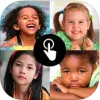Take a look inside 5 images
Touch and Learn - Emotions
Pros: The extremely simple user interface lets kids focus on emotions.
Cons: Some images could identify more than one emotion, which could confuse some kids.
Bottom Line: Bridges the gap between feeling or witnessing emotions and using words to describe them.
Touch and Learn - Emotions can be an extremely useful tool for helping kids who are struggling to relate to and empathize with other kids, or who find it difficult to express their emotions using words. Be sure to use all of the settings to customize play, focus on certain emotions, and add your own lists. After kids practice identifying emotions on this app, act out some of the facial expressions and body language for various emotions to see if they've made the connection between the images and words that they've seen and heard with active expression. Then give each student a turn acting out an emotion for you or their classmates to guess what they're expressing. This app doesn't touch on how kids can effectively express these emotions when feeling them ("I am feeling so angry right now" vs. "You are making me angry"), so teachers may want to use it as a springboard and supplement the lesson by teaching that next-step skill as well.
Touch and Learn - Emotions is a free app that helps kids learn to identify and name emotions, facial expressions, and body language. Kids see four pictures of people and hear a narrator speak an emotion-related word, then tap the image of the person who most looks like they are feeling that emotion, such as "afraid," "hungry," upset," or "scared." This very simple game includes more than 100 images of real people of various ages, ethnicities, and emotional states. Teachers can customize the words and photos, include their own voice recordings, or use the settings to choose just one or a few categories of emotions for kids who need extra help with specific concepts. You can customize the success messages that reward kids.
Kids can learn to identify a wide range of positive and negative emotions using Touch and Learn - Emotions. Understanding emotions can help kids in many ways, including improving communication with other kids and adults and helping kids get more comfortable expressing their own feelings. The recommended age for this app is limited to preschool or early elementary school, but its usefulness can stretch far beyond that for kids with special needs related to social cues and emotional awareness. It addresses Common Core State Standards related to learning age-appropriate vocabulary, using those words in real life, and expressing emotions clearly.
Teachers will likely want to customize Touch and Learn - Emotions, and it could use a more in-depth tutorial to maximize its full learning potential. Fortunately, the settings option allows adults to adjust which images link to which emotions and set images to match more than one emotion. Overall, this app is an excellent way for kids to practice identifying emotions, body language, and facial expressions.














